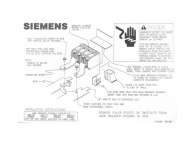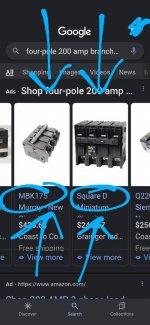You are using an out of date browser. It may not display this or other websites correctly.
You should upgrade or use an alternative browser.
You should upgrade or use an alternative browser.
Using feed thru lugs to feed a panel?
- Thread starter tortuga
- Start date
- Status
- Not open for further replies.
And yeah I exaggerated when I told OP he would have to run 4 new parallel conductors to the inside house panel.
Technically he could run four conductors out of the breaker and then combine them (Polaris, etc) to a single larger conductor in a j box nearby, and then run the 2 larger conductors.
It's what I did.
Sent from my Pixel 4a (5G) using Tapatalk
Technically he could run four conductors out of the breaker and then combine them (Polaris, etc) to a single larger conductor in a j box nearby, and then run the 2 larger conductors.
It's what I did.
Sent from my Pixel 4a (5G) using Tapatalk
Neat idea, in the original job (now long done) I looked into that and a lug kit, it was an existing Siemens panel, all Siemens residential panels have a sticker that limits the branch breakers to type QP or QPH (and in some cases Murry MP-T and ITE types), also on some outdoor panels I have noticed the sticker limits branch breakers from 75 -100 Amps in some cases. The largest QP breaker one can get is 125 AmpsSee 2 examples of a.
Murray (they have a Siemens too) and Square D.
Sent from my Pixel 4a (5G) using Tapatalk
Additionally the manufacturers instructions for those mains prohibit their use as a branch breaker:

electrofelon
Senior Member
- Location
- Cherry Valley NY, Seattle, WA
- Occupation
- Electrician
I think the one you are showing there is specifically a main breaker. See a Q2200B for the version that is intended as a branch breaker.Neat idea, in the original job (now long done) I looked into that and a lug kit, it was an existing Siemens panel, all Siemens residential panels have a sticker that limits the branch breakers to type QP or QPH (and in some cases Murry MP-T and ITE types), also on some outdoor panels I have noticed the sticker limits branch breakers from 75 -100 Amps in some cases. The largest QP breaker one can get is 125 Amps
Additionally the manufacturers instructions for those mains prohibit their use as a branch breaker:
View attachment 2560249
LarryFine
Master Electrician Electric Contractor Richmond VA
- Location
- Henrico County, VA
- Occupation
- Electrical Contractor
That's where the two A-phase load terminals (i.e., 1 and 3) join into one lug, and the two B-phase load terminals (i.e., 2 and 4) join into the other lug.Yeah you're right the last solution the Square D breaker takes four spaces on the bus.
You can see on the photo, the part with the label protrudes into the wire way more than a typical breaker would.
LarryFine
Master Electrician Electric Contractor Richmond VA
- Location
- Henrico County, VA
- Occupation
- Electrical Contractor
Couldn't that combining be done in the panel, space permitting, say at the top or bottom?Technically he could run four conductors out of the breaker and then combine them (Polaris, etc) to a single larger conductor in a j box nearby, and then run the 2 larger conductors.
good tip, well you can still run into panel stickers that limit the size of breakers, especially in service meter / main combos.I think the one you are showing there is specifically a main breaker. See a Q2200B for the version that is intended as a branch breaker.
Here is one that is 80 amps per 'stab' limited:
I don't see why not.Couldn't that combining be done in the panel, space permitting, say at the top or bottom?
A three terminal Polaris that size can be quite big.
If there are many wires in the panel it's hard to squeeze it in sometimes.
Sent from my Pixel 4a (5G) using Tapatalk
TBH, I may, or may not!, have actually used that main breaker (with the bent bus bars removed) as a branch breaker. Not saying I did!Neat idea, in the original job (now long done) I looked into that and a lug kit, it was an existing Siemens panel, all Siemens residential panels have a sticker that limits the branch breakers to type QP or QPH (and in some cases Murry MP-T and ITE types), also on some outdoor panels I have noticed the sticker limits branch breakers from 75 -100 Amps in some cases. The largest QP breaker one can get is 125 Amps
Additionally the manufacturers instructions for those mains prohibit their use as a branch breaker:
View attachment 2560249
I'll focus on getting the branch breaker in future.
Sent from my Pixel 4a (5G) using Tapatalk
mtnelect
HVAC & Electrical Contractor
- Location
- Southern California
- Occupation
- Contractor, C10 & C20 - Semi Retired
This PV thing can really get expensive:
1. Most older homes will need a panel upgrade
2. Most older homes will need a new roof (Putting it on an old roof)
3. New meter Combo Panels in California now have a sticker "Reserved for Solar" (which hardly anyone follows)
1. Most older homes will need a panel upgrade
2. Most older homes will need a new roof (Putting it on an old roof)
3. New meter Combo Panels in California now have a sticker "Reserved for Solar" (which hardly anyone follows)
jaggedben
Senior Member
- Location
- Northern California
- Occupation
- Solar and Energy Storage Installer
The age of a home doesn't necessarily correspond to any of that. Most older homes have already gotten a new panel and a new roof at some point.This PV thing can really get expensive:
1. Most older homes will need a panel upgrade
2. Most older homes will need a new roof (Putting it on an old roof)
3. New meter Combo Panels in California now have a sticker "Reserved for Solar" (which hardly anyone follows)
Your #3 doesn't have a real impact on cost.
Frankly, a lot of your posts seem like anti-solar trolling.
kwired
Electron manager
- Location
- NE Nebraska
- Occupation
- EC
Art 100 doesn't define the word "conductor" that leaves us with dictionary definitions which would be pretty much anything that is conductive.When the NEC refers to "conductor" many people think it only means wires, but in the NEC conductors are anything that is intended to conduct electricity in a circuit. So bus, wire, cables, bus duct, etc. are all conductors in the NEC. As far as the NEC is concerned 'Where an overcurrent device is installed at the supply end of the feed-through conductors' means at the supply end of the busbar. Conductors encompass the panel busbar and the conductors on the feedthrough lugs going to a downstream panel. The conductors on the feedthrough lugs are really just a busbar extension. If you look at them like that everything just follows along. Treat it like one long busbar from the main OCPD to wherever it lands at the next OCPD.
Art 100 does have definition for these terms though:
conductor, bare
conductor, covered
conductor, insulated
And I think there are places it references the conductor types recognized by art 310 (which is primarily insulated conductors) scattered about the code.
electrofelon
Senior Member
- Location
- Cherry Valley NY, Seattle, WA
- Occupation
- Electrician
Lots of things "can" get expensive. I mostly do ground mounts and almost always use 230.40 exception 3 from the meter socket so I'm not dealing with roofs or the house panel. If we were dealing with the house panel, actually rarely do I see needing to do a panel upgrade to connect a PV system.This PV thing can really get expensive:
1. Most older homes will need a panel upgrade
2. Most older homes will need a new roof (Putting it on an old roof)
3. New meter Combo Panels in California now have a sticker "Reserved for Solar" (which hardly anyone follows)
- Status
- Not open for further replies.



